Three days the Cambodians celebrate their Khmer New Year. So a lot of time for exuberant celebrations. While the celebrations in the pagodas begin on the day the angel arrives in the afternoon, preparations for this meaningful Khmer feast have been going on for weeks in Siem Reap. Not only the houses are decorated, but also the streets shine in festive splendour. Garlands, fairy lights as far as the eye can see. And of course pigs, in keeping for the new year.
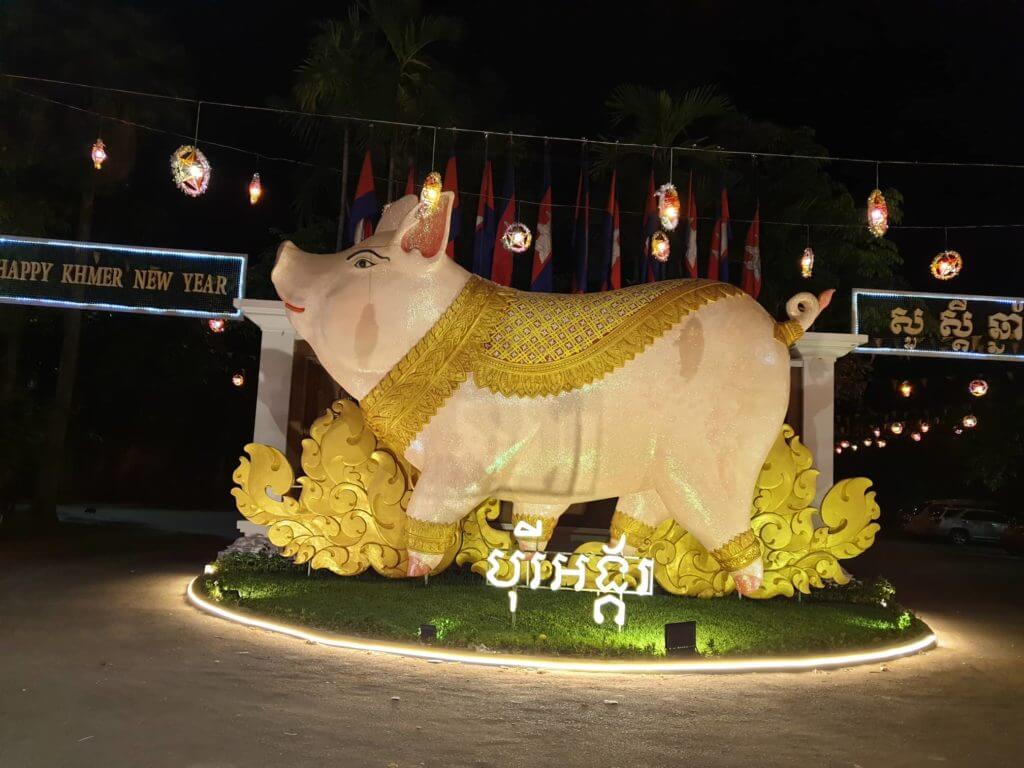
Angkor Sangkranta (អង្គរសង្ក្ក្រាន្ត) in Angkor Park
Since 2013, the Union of Youth Federations of Cambodia (UYFC) has organised Angkor Sangkranta at the Angkor Archaeological Park. With dance performances and games. World records have also been set, such as the biggest sticky rice or Madison Dance with 2,015 participants. According to a report in the Khmer Times, this year the events will take place throughout the country for the first time. It says there will be a Siem Reap Sankranta instead of the Angkor Sankranta. Next year, in 2020, there will be another Angkor Sankranta. And it will be even more beautiful and bigger than before.
Teagn Prot – Tug of War
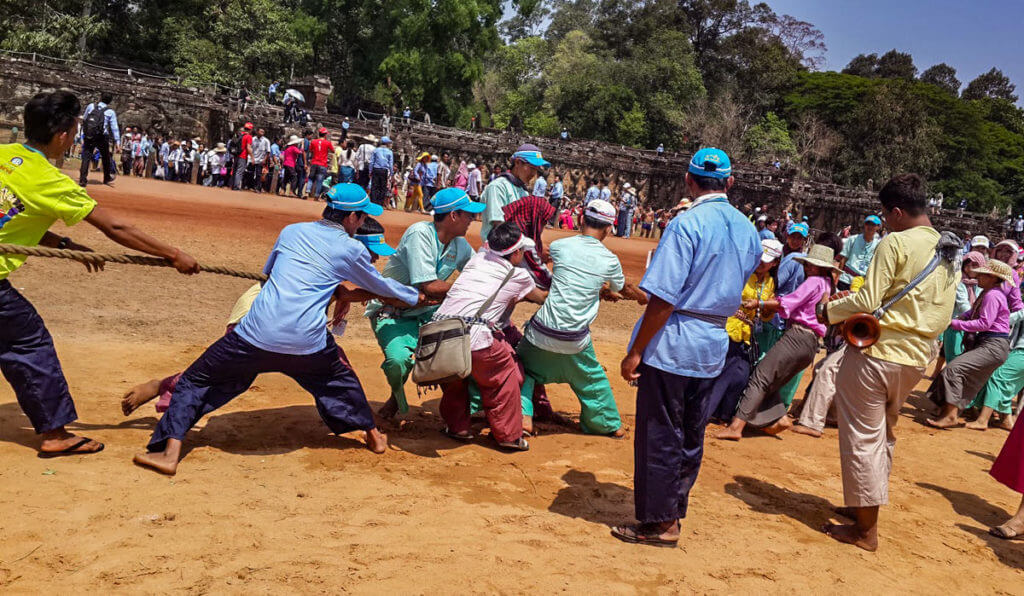
In tug-of-war – Teagn Prot – a male and a female team are playing against each other. They show their strengths to each other by pulling the rope. The goal is to pull the rope and the opposing team into their own playing field. Teagn Prot has a number of important stories in Khmer culture, as the following folk tale shows. The hidden meanings reach far into the history of Cambodia.
Legend behind Teagn Prot
The giants and angels came together to stir and dry the ocean. It was about preserving the elixir of life so that they could live forever. They used a snake called Vasuki as a rope to move and turn Montakrak Mountain. Vishnu, the mighty god, turned into a turtle to support the mountain. The angels pulled at the head of the snake, while the giants pulled at the tail. While turning, the snake became dizzy, spitting poison and breathing fire through its tongue. This produced rain in the celestial sphere that fell down to earth.
Pulling the rope is therefore similar to pulling the snake and is still considered a rain ceremony today.
A reading tip: Another saga about Teagn Prot can be found at Khmer Chhankitek Calendar.
Bos Angkunh
At Bos Angkunh (also called “Angkung”, “Bas Angkunh”, “Ong Coon” or “Ang Kunch”, translated = “throwing brown nuts”) the nuts of the Angkunh tree are the main game pieces since hundreds of years.
Angkunh is a tree fruit that is mainly found in the Cambodian regions of Stung Treng and Kratie. The 5 cm nut is flat on both sides and looks a bit like a flat and oversized chestnut. Angkunh is extremely hard and dark brown in colour. In the Angkunh game two teams compete against each other. The two teams face each other and place Angkunh nuts on the floor in front of each other. One of the typical formations consists of 2 rows with a total of 7 nuts. In the back row there are 4 nuts and in the front row there is 1 nut in intervals, so 3 nuts. There are also variants with 5 or only 3 Angkunh nuts. There are different rules for Angkunh, here is one of them.
Negotiations at the beginning of each game
Before the game begins, the parties negotiate:
- the number of points needed to win the game
- the “punishment” for the losing team (e.g. carrying the winners around on their back … )
- by use of ” Schnick, Schnack, Schnuck” which team is allowed to begin
Once clarified, the game begins and the first player of the starting team throws an Angkunh-nut on the nuts of the opposing team. For each nut hit there is one point and the player gets his nut back for the next throw when it’s his turn again. Each player has one throw until one player of a team does not hit a nut. Then the round goes to the opposing team.
The game continues until the agreed number of points is reached and the winning team is determined. The team wins the right to “gently” beat the bent knee of the loser with the two flat sides of the fruit. The resulting noise causes a lot of amusement among the players. However, if the right tone is not heard, the losers can hit the winner’s knees.
Chab Kon Kleng
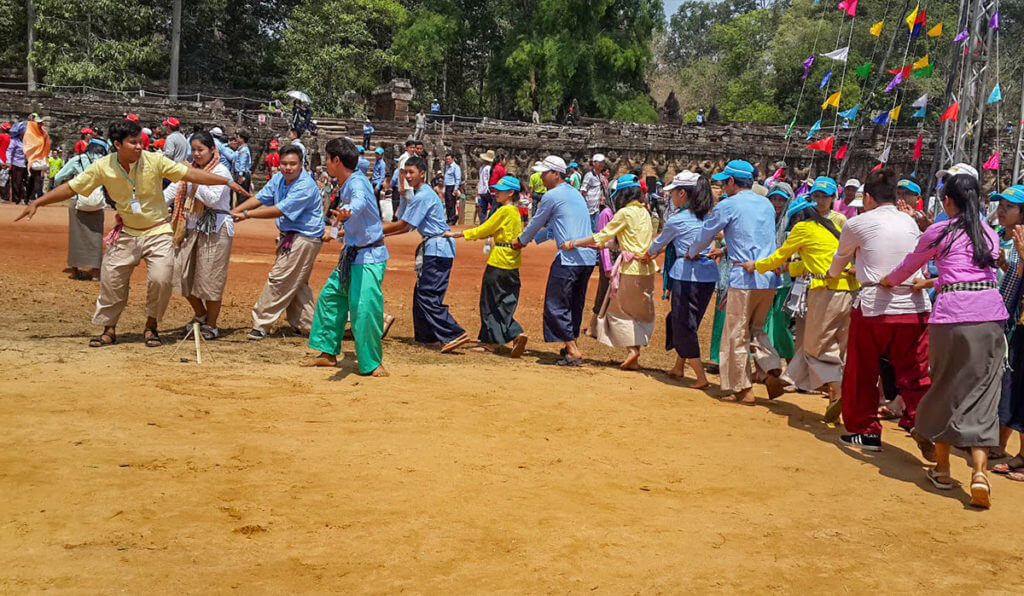
This game is mainly played by adults on the first New Year’s Day or the night of the first New Year’s Day. A player with the strongest body structure imitates a hen protecting her chicks from another player imitating a crow. While the other players hide behind the hen as chicks, the crow tries to catch as many chicks as possible.
Here’s a video about this game.
Choal Chhoung
This game is particularly popular among young Cambodians, as it offers the opportunity to meet other sex. The game is played with a ball of rolled Krama – the typical Cambodian scarf – with one end of the scarf sticking out.
The two opposing teams each consist of a boys’ and a girls’ team. The game begins when a boy throws the stuff ball into the air. Before the ball touches the ground, the girl team must catch the Krama at its end.
When a girl on the girls’ team has caught the Krama ball, she will quickly throw it back to the boys’ team. This with the aim of hitting exactly the boy the girl likes. If one of the boys is hit by the ball, the boys’ team loses the game. The girls’ team dances in front of the boys’ team to tap the boys’ palms as a prize while the boys’ team sings.
If none of the girls can catch the Krama Ball, all they have to do is pick it up and throw it back into the air for the boys team to catch it. Whenever an opposing team member can catch the ball, they must quickly throw it back and aim at a girl/boy they like.
Old song by Chaol Chhoung
Boy: I throw the Chhoung and I aim at my lover. Be very careful, my love, that my Chhoung does not touch the ground.
Girl: Throw it to me. And don’t worry. If the Chhoung touches the ground, I will sing for you.
Boy: Here’s the Chhoung, be careful or you’ll even sing twice. Wait a while before you throw the Chhoung back. I see bananas in the south and flowering banana trees. Accompanied by thirty friends, he comes to ask for the young girl’s hand. The father says no, but the mother says yes. She gives him her daughter, and looks forward to the pig heads (the wedding present). I look south and clearly see some coconut palms. Would you please tell the beautiful girl that I shouldn’t take a husband?
Hint for reading: The game Chhoung comes in different variations. Khmer Chhankitek Calendar will tell you all about it.
Leak Kanseng
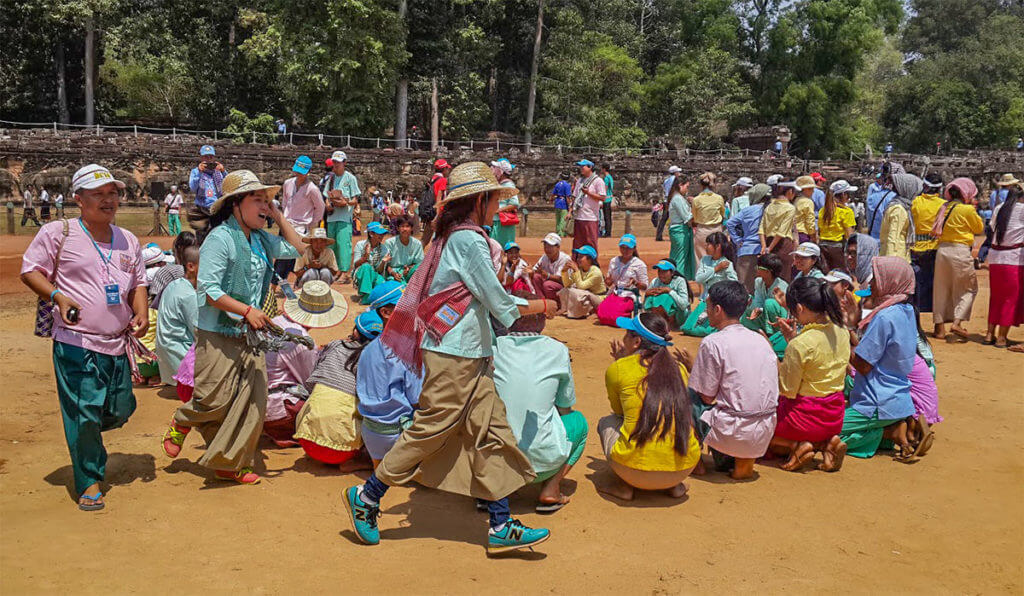
In this game the players sit in a circle on the floor. One of the players holds a “Kanseng” (Cambodian towel) in his hands, walks around the outside of the circle and sings: “Hide the Kanseng, the cat bites the heel and pulls the leg”.
Leak Kanseng!
Song of Leak Kanseng
Chhma khaaim keng!
Oh long oh long
Meanwhile the player secretly puts the “Kanseng” behind one of the other players on the floor. Together with his neighbor, this player jumps up and pursues him. If the player does not manage to catch up with his neighbour until he has returned to his seat, he runs around the circle himself and puts the towel behind another child from the circle.
Here is a little video where you can also hear how the children hear “Leak Kanseng! Chhma khaaim keng! Oh long oh long” sing.
Bay Khom(បាយខុម)
A game played by two children in their spare time in rural or urban areas. Ten holes are dug into a board in the ground in the shape of an oval. The game is played with 42 small pearls, stones or fruit seeds. Before the game starts, five beads are placed in each of the two holes at the top of the board. Four beads are placed in each of the remaining eight holes.
According to the description this game doesn’t really come across as being played especially for the Cambodian New Year. But it is mentioned in the English Wikipedia.
The first player takes all beads from one hole and drops them one after the other into the other holes. He or she must repeat this process until he or she has dropped the last bead into a hole next to an empty hole. Then the player must remove all the beads from the hole that follows the empty hole. This continues until the last empty hole is followed by two more empty holes or a full hole.
At the end, the player with the largest number of beads wins.
Breaking Pot
One of the most popular games during the Cambodian New Year holidays. Thin clay pots with flour and a small price (usually something sweet) are hung on a rope between trees. The aim of the game is to smash one of the pots with a stick while blindfolded. The player follows the direction of the screaming crowd and tries to find the right position to hit the pot. If the player hits the pot, there is first a flour “shower” while the others already collect the sweets from the ground :-)
Tres
The rules of the game are very simple, whereas the performance is much more tricky. Using one hand to throw a ball and catch it while the player tries to catch an increasing number of sticks with the other hand, e.g. chopsticks or pens.
The Trot Dance
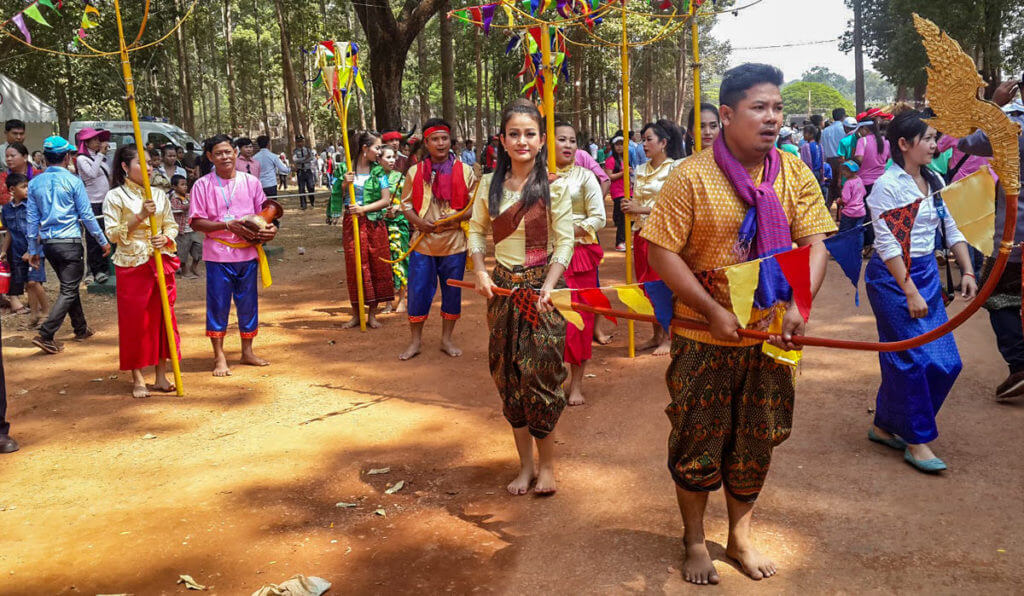
Not really a game, but still increasingly popular during the Cambodian New Year holidays: The “Trot” Dance, also called “Robam Trot”. Trot means “the end” and means the end of last year.
The Trot dance and its myths
The dance tells a story, which is based on different folk tales. One of the fairy tales says that Buddha was first a monk before he attained enlightenment. On his way there, the Buddha appeared a golden deer camouflaged devil who blocked his path. Buddha began to pray to an angel. The angel came down and appeared as a hunter to kill the golden stag and accompanied Buddha on his way to become a monk.
The main actor wears a Kangcha, an approximately 2.5 metre long pole, the front part of which is curved. The two ends of the pole are connected by a cord and decorated with the nuts of Angkuhn and metal pieces. Those make noises and set the beat for other instruments.
Hint for reading: You can also find more information about the Trot dance at Khmer Chhankitekt Calendar.
Water pistols everywhere
By the way: If you are in Cambodia during the holidays for the Cambodian New Year, then you will surely encounter one or the other water pistol. Well, I’ll say, it’s a modern variation on the rain rituals … :-)
So now you are an expert with playing those games during Khmer New Year. Have fun!
Articles about Khmer New Year
Many articles about Angkor have already appeared here at Visit Angkor. Here is a small selection. Click on the link “Khmer New Year” to find all articles in this category.
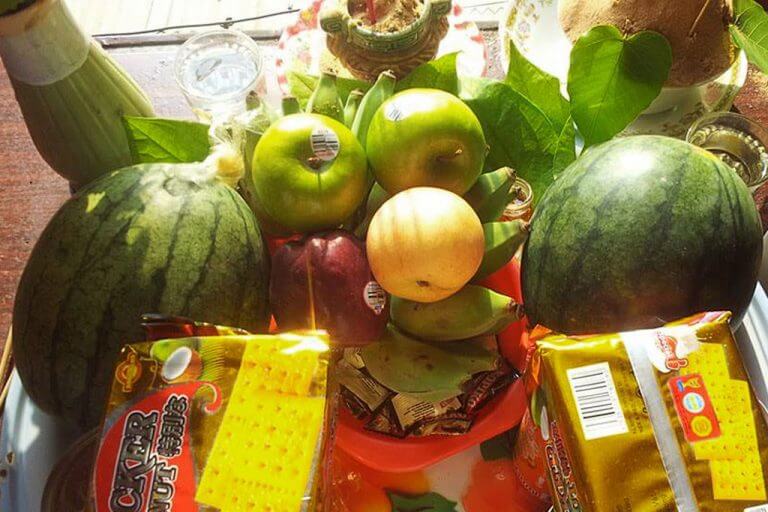
Khmer New Year 2025 – welcome to Angel Koraka Tevy
This year, Monday angel Koraka Tevy comes down to earth on 15 April 4:48 am. She is the second daughter of Kabil Moha Prum. Happy Khmer New Year 2014
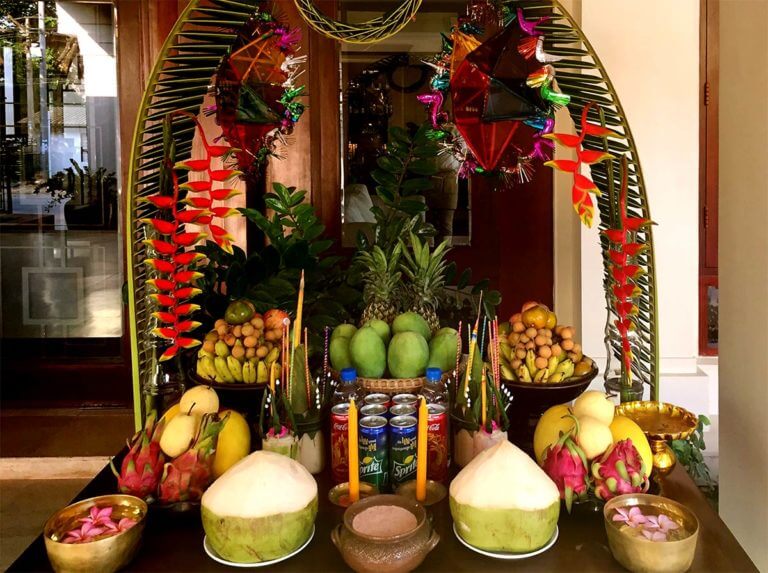
Khmer New Year 2024: Welcome Angel Mohothareak Tevy
On 13 April, Angel Mohothareak comes to earth and the Year of the Dragon begins. Information about the angel and the New Year festival in Cambodia.
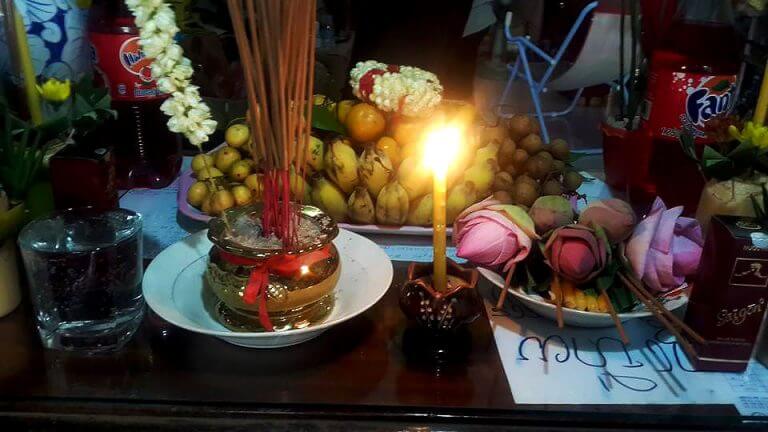
Khmer New Year 2021 – welcome to Angel Mondar Tevy
New Year Angel of the ox Year, Buddhist Era 2564 Angel Mondar Tevy (The Wednesday Angel) arrives at 4 am in the morning of April 14 – Cambodian time. She is the fourth daughter of Kabil Moha Prum. People in Cambodia have prepaired and decorated their houses also with special gifts to welcome the New Year Angel. The…

Affiliate*
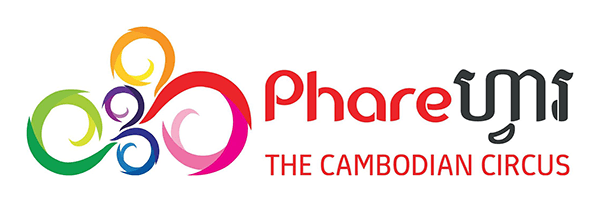
Phare, the Cambodian Circus
A highlight in Siem Reap! Buy tickets online directly on the Circus Phare website*.
Links and references with a * are an affiliate link (advertising link). If you like Visit Angkor and buy, book or subscribe to something via an affiliate link, the provider will make a small commission for Visit Angkor. Of course, there are no additional costs for you.
Join our Facebook group
International travel group with friendly people who love Cambodia. We speak English, German and a little Khmer.
By the way: We write here at Visit Angkor with a lot of passion and love. Nevertheless, it can happen that information is no longer up to date or perhaps even incorrect. We would be happy to hear from you so that we can update the information accordingly. Thank you very much!


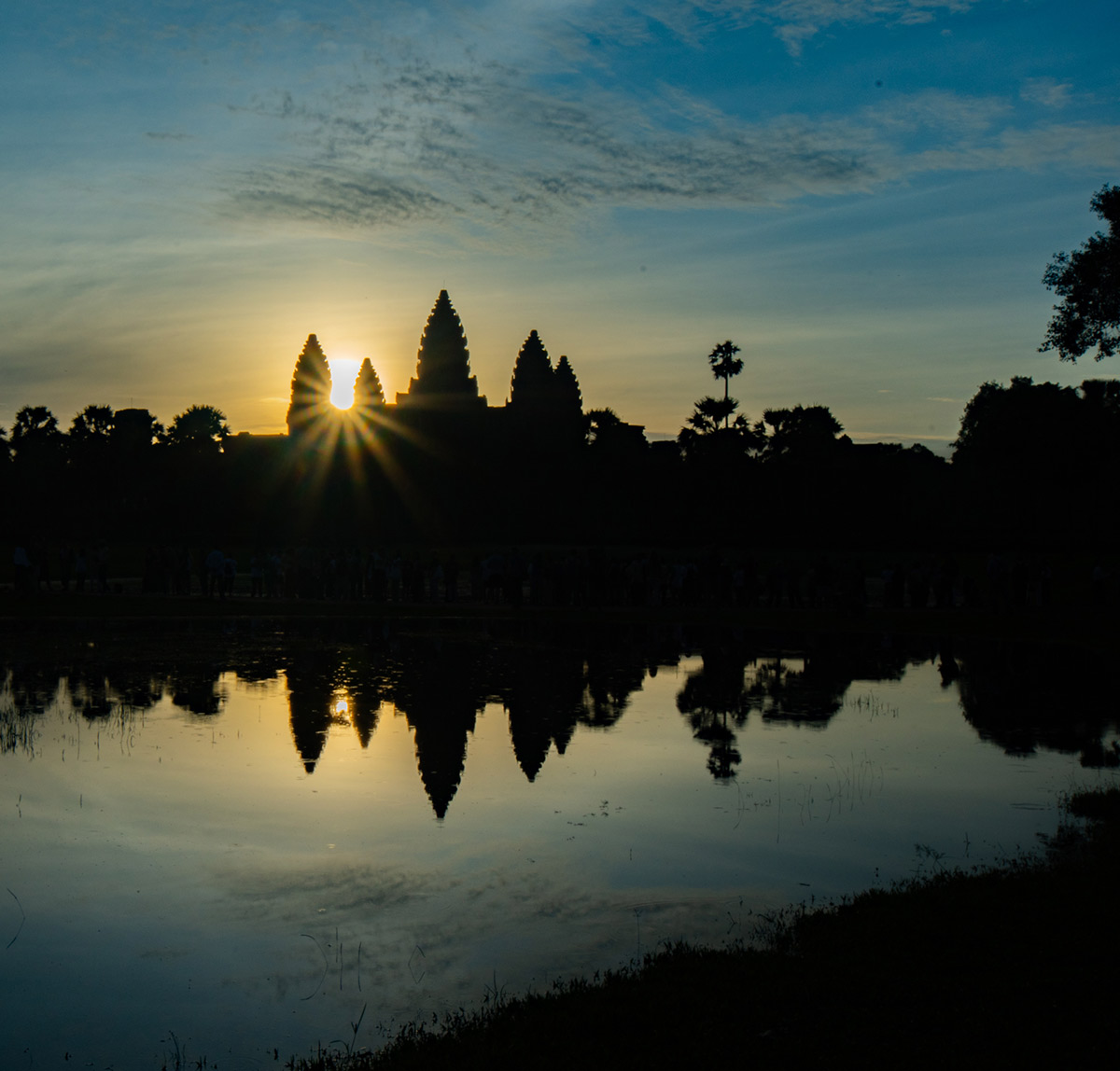

Cambodia is most pretty to discover new cultures and traditions. Everyone going to visit Cambodia. Lot of naturals spots, tourist spots are there.Thanks for sharing!